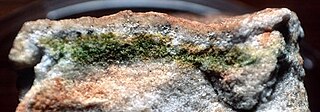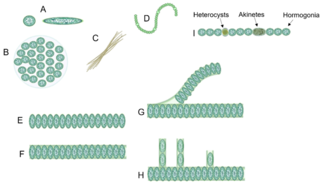
Cyanobacteria, also called Cyanobacteriota or Cyanophyta, are a phylum of autotrophic gram-negative bacteria that can obtain biological energy via oxygenic photosynthesis. The name "cyanobacteria" refers to their bluish green (cyan) color, which forms the basis of cyanobacteria's informal common name, blue-green algae, although as prokaryotes they are not scientifically classified as algae.

An endolith or endolithic is an organism that is able to acquire the necessary resources for growth in the inner part of a rock, mineral, coral, animal shells, or in the pores between mineral grains of a rock. Many are extremophiles, living in places long considered inhospitable to life. The distribution, biomass, and diversity of endolith microorganisms are determined by the physical and chemical properties of the rock substrate, including the mineral composition, permeability, the presence of organic compounds, the structure and distribution of pores, water retention capacity, and the pH. Normally, the endoliths colonize the areas within lithic substrates to withstand intense solar radiation, temperature fluctuations, wind, and desiccation. They are of particular interest to astrobiologists, who theorize that endolithic environments on Mars and other planets constitute potential refugia for extraterrestrial microbial communities.

Cyanotoxins are toxins produced by cyanobacteria. Cyanobacteria are found almost everywhere, but particularly in lakes and in the ocean where, under high concentration of phosphorus conditions, they reproduce exponentially to form blooms. Blooming cyanobacteria can produce cyanotoxins in such concentrations that they can poison and even kill animals and humans. Cyanotoxins can also accumulate in other animals such as fish and shellfish, and cause poisonings such as shellfish poisoning.

Phototrophic biofilms are microbial communities generally comprising both phototrophic microorganisms, which use light as their energy source, and chemoheterotrophs. Thick laminated multilayered phototrophic biofilms are usually referred to as microbial mats or phototrophic mats. These organisms, which can be prokaryotic or eukaryotic organisms like bacteria, cyanobacteria, fungi, and microalgae, make up diverse microbial communities that are affixed in a mucous matrix, or film. These biofilms occur on contact surfaces in a range of terrestrial and aquatic environments. The formation of biofilms is a complex process and is dependent upon the availability of light as well as the relationships between the microorganisms. Biofilms serve a variety of roles in aquatic, terrestrial, and extreme environments; these roles include functions which are both beneficial and detrimental to the environment. In addition to these natural roles, phototrophic biofilms have also been adapted for applications such as crop production and protection, bioremediation, and wastewater treatment.
Cyanobionts are cyanobacteria that live in symbiosis with a wide range of organisms such as terrestrial or aquatic plants; as well as, algal and fungal species. They can reside within extracellular or intracellular structures of the host. In order for a cyanobacterium to successfully form a symbiotic relationship, it must be able to exchange signals with the host, overcome defense mounted by the host, be capable of hormogonia formation, chemotaxis, heterocyst formation, as well as possess adequate resilience to reside in host tissue which may present extreme conditions, such as low oxygen levels, and/or acidic mucilage. The most well-known plant-associated cyanobionts belong to the genus Nostoc. With the ability to differentiate into several cell types that have various functions, members of the genus Nostoc have the morphological plasticity, flexibility and adaptability to adjust to a wide range of environmental conditions, contributing to its high capacity to form symbiotic relationships with other organisms. Several cyanobionts involved with fungi and marine organisms also belong to the genera Richelia, Calothrix, Synechocystis, Aphanocapsa and Anabaena, as well as the species Oscillatoria spongeliae. Although there are many documented symbioses between cyanobacteria and marine organisms, little is known about the nature of many of these symbioses. The possibility of discovering more novel symbiotic relationships is apparent from preliminary microscopic observations.

The Belgian Co-ordinated Collections of Micro-organisms (BCCM) is a Belgian government funded consortium of seven scientific institutions, who manage and exploit a collection of microbial and genetic resources. The consortium comprises more than 269,000 publicly available strains of bacteria including mycobacteria and cyanobacteria, filamentous fungi, yeasts, diatoms and plasmids.

Ornithocercus is a genus of planktonic dinoflagellate that is known for its complex morphology that features considerable lists growing from its thecal plates, giving an attractive appearance. Discovered in 1883, this genus has a small number of species currently categorized but is widespread in tropical and sub-tropical oceans. The genus is marked by exosymbiotic bacteria gardens under its lists, the inter-organismal dynamics of which are a current field of research. As they reside only in warm water, the genus has been used as a proxy for climate change and has potential to be an indicator species for environmental change if found in novel environments.

Scytonemin is a secondary metabolite and an extracellular matrix (sheath) pigment synthesized by many strains of cyanobacteria, including Nostoc, Scytonema, Calothrix, Lyngbya, Rivularia, Chlorogloeopsis, and Hyella. Scytonemin-synthesizing cyanobacteria often inhabit highly insolated terrestrial, freshwater and coastal environments such as deserts, semideserts, rocks, cliffs, marine intertidal flats, and hot springs.

Microcystis aeruginosa is a species of freshwater cyanobacteria that can form harmful algal blooms of economic and ecological importance. They are the most common toxic cyanobacterial bloom in eutrophic fresh water. Cyanobacteria produce neurotoxins and peptide hepatotoxins, such as microcystin and cyanopeptolin. Microcystis aeruginosa produces numerous congeners of microcystin, with microcystin-LR being the most common. Microcystis blooms have been reported in at least 108 countries, with the production of microcystin noted in at least 79.
Roseli Ocampo-Friedmann was a Filipino-American microbiologist and botanist who specialized in the study of cyanobacteria and extremophiles. Her work has been cited in work exploring the terraforming of Mars.

Arthur Robert Grossman is an American biologist whose research ranges across the fields of plant biology, microbiology, marine biology, phytochemistry, and photosynthesis. He has been a staff scientist at Carnegie Institution for Science’s Department of Plant Biology since 1982, and holds a courtesy appointment as professor in the Department of Biology at Stanford. He has mentored more than fifteen PhD students and more than thirty post-doctoral fellows. Grossman was the recipient of the Gilbert Morgan Smith Medal in 2009 and the Darbaker Prize for work on microalgae in 2002. He is co-editor in chief of Journal of Phycology, and has been on the editorial boards of major biological journals including the Annual Review of Genetics, Eukaryotic Cell, Journal of Biological Chemistry, and Molecular Plant among others. He has also been on many committees and panels that evaluate scientific directions for the various granting agencies, universities and government departments. He was elected the co-chair of the Gordon Research Conference on Photosynthesis in 2015, and will be chair again in 2017. He is Chief of Genetics at Solazyme Inc. which applies plant biology to create oils.
Vivian Helena Pellizari is a Brazilian Antarctic scientist known for her work on establishing Antarctic microbiology in Brazil. Pellizari is the head of Department of Oceanographic Biology at Oceanographic Institute of University of São Paulo.
Trichodesmium thiebautii is a cyanobacteria that is often found in open oceans of tropical and subtropical regions and is known to be a contributor to large oceanic surface blooms. This microbial species is a diazotroph, meaning it fixes nitrogen gas (N2), but it does so without the use of heterocysts. T. thiebautii is able to simultaneously perform oxygenic photosynthesis. T. thiebautii was discovered in 1892 by M.A. Gomont. T. thiebautii are important for nutrient cycling in marine habitats because of their ability to fix N2, a limiting nutrient in ocean ecosystems.
Gloeocapsin is an extracellular pigment of some cyanobacteria, believed to provide UV-protection to the cell. It is especially abundant in cyanobacterial species that inhabit places exposed to high levels of sunlight, such as the surface of rocks. In natural samples, the identification of gloeocapsin is based on its property to change color with varying pH, ranging from purple in alkaline media to red in acidic media. It is named after the cyanobacterial genus Gloeocapsa where it was first identified. Its chemical structure is yet to be identified.

Sea Ice Microbial Communities (SIMCO) refer to groups of microorganisms living within and at the interfaces of sea ice at the poles. The ice matrix they inhabit has strong vertical gradients of salinity, light, temperature and nutrients. Sea ice chemistry is most influenced by the salinity of the brine which affects the pH and the concentration of dissolved nutrients and gases. The brine formed during the melting sea ice creates pores and channels in the sea ice in which these microbes can live. As a result of these gradients and dynamic conditions, a higher abundance of microbes are found in the lower layer of the ice, although some are found in the middle and upper layers. Despite this extreme variability in environmental conditions, the taxonomical community composition tends to remain consistent throughout the year, until the ice melts.
Microbial DNA barcoding is the use of DNA metabarcoding to characterize a mixture of microorganisms. DNA metabarcoding is a method of DNA barcoding that uses universal genetic markers to identify DNA of a mixture of organisms.

Cyanobacterial morphology refers to the form or shape of cyanobacteria. Cyanobacteria are a large and diverse phylum of bacteria defined by their unique combination of pigments and their ability to perform oxygenic photosynthesis.
Greta Albrecht Fryxell was a marine scientist known for her work on the biology and taxonomy of diatoms. In 1996, she was elected a fellow of the American Association for the Advancement of Science.
Linda Karen Medlin is a molecular biologist known for her work on diatoms. She is an elected member of the Norwegian Academy of Science and Letters.
Norma J. Lang was a phycologist and Professor of Plant Biology, Emerita at the University of California, Davis from 1963 to 1991. Her research primarily focused on understanding the structure of green algae and cyanobacteria.











